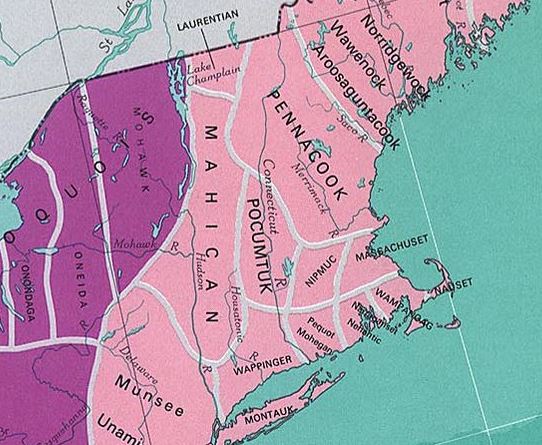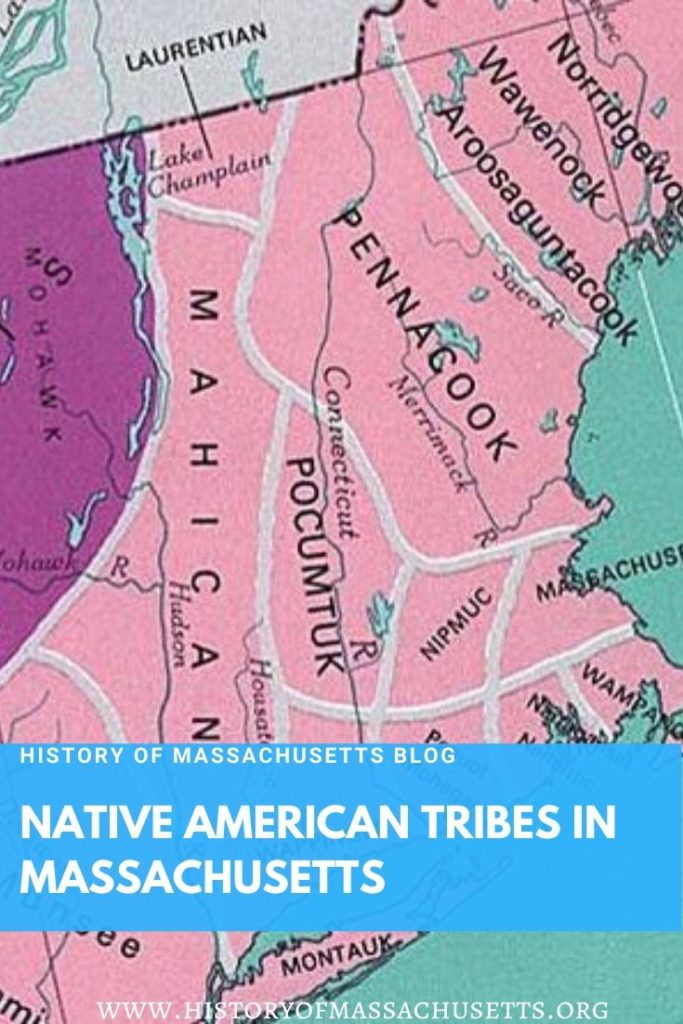Indigenous people have lived in Massachusetts for 12,000 years. The first known inhabitants of Massachusetts were Paleoindians who moved into New England just as the glaciers were retreating at the end of the last ice age.
Over thousands of years, the population of indigenous people greatly increased and became more widespread throughout the region. These indigenous people formed distinct tribes and bands that we now recognize as Native-American tribes.
By the 16th century, New England was home to 100,000 Native people, with many residing in Massachusetts. Even today, there are still 37,000 Native-Americans living in Massachusetts, according to the 2010 Federal Census.
The following is a list of Native American tribes that lived in Massachusetts:
Mahican Tribe:
The Mahicans were originally centered in New York but had bands or sub-tribes that migrated to Massachusetts, Connecticut and Vermont in the late 17th century.
There were at least five divisions of sub-tribes within the Mahican confederacy: the Mahican proper, Wiekagjoc, Mechkentowoon, Wyachtonoc and the Westenhuck (Stockbridge).

In Massachusetts, the Mahican tribe lived in Berkshire County where they were mainly represented by the sub-tribe of the Stockbridge.
Prior to colonization, in 1600, there were 4,000 to 5,000 Mahicans living in Mahican territory in New York (Prtizker 425.)
The Mahicans lived in large villages that consisted of about 20 to 30 communal longhouses, which were about 20 feet wide and sometimes as long as 180 feet, made from planted hickory saplings tied together at the top, to form a type of garden arbor, that was then covered in reeds and bark (Hodge 787.) Their villages were fortified by palisade walls and were located on hills.
The Mahicans were hunters and gatherers but also practiced cultivation by growing corn and other crops.
The Mahicans frequently fought with a neighboring tribe, the Mohawks. In the Hudson Valley, the Mahicans and the Mohawks became embroiled in a war, from 1624 to 1628, which eventually drove the Mahicans east to Albany.
During another conflict with the Mohawks, the Beaver Wars in 1680, the Mahicans were driven southeast, across the modern day border of Massachusetts, to Stockbridge, Massachusetts, where they settled and formed a sub-tribe of the same name.
Massachusett Tribe:
The Massachusett tribe lived in the area of the Massachusetts Bay, specifically between Salem and Brockton.
Both the Massachusetts Bay colony and the Commonwealth of Massachusetts were named after the tribe.
The early colonists often referred to the Massachusett tribe as the Aberginians or Aberginny-men, for reasons unknown, although it’s possible it was adapted from the word “aborigines.”
Prior to colonization, in 1600, it is believed that there were around 3,000 Massachusett Indians in the state (Hodge 816.)
From 1615-19, the Massachusett tribe became embroiled in a war with the Tarrantine (Penobscot) tribe of Maine, during which they suffered heavy losses, which greatly reduced their numbers.
From 1616-1619, the Massachusett were hit hard by an epidemic, possibly smallpox, that further decimated their numbers.
Nauset Tribe:
The Nauset tribe lived on Cape Cod and were also known as the Cape Indians. Since they lived so close to the ocean, their diet consisted mostly of seafood, although they also grew corn, beans and squash.
Prior to colonization, in 1600, it is believed there were around 1,200 Nauset Indians in Massachusetts (Swanton 22.)
Their close proximity to the coast meant that many first encounters between Europeans and natives were with the Nauset tribe.
In 1606, French explorer Sieur De Monts had several encounters with the Nauset and the tribe attacked De Monts and his crew on at least two occasions, both times with deadly results.
In 1614, English explorer Captain Thomas Hunt captured seven Nauset Indians as well as 20 Wampanoag indians. Then, in 1620, the Nauset attacked the pilgrims in Provincetown, prompting them to pick up anchor and sail to Plymouth instead.
The Nauset tribe lived in villages of what French explorer Samuel de Champlain described as thatched-roof “cabins” that had a smoke hole in the center of the roof.
The tribe appeared to be unaffected by the epidemic of 1616, although they were affected by later epidemics.
Nipmuc Tribe:
The Nipmuc tribe lived primarily in the central plateau of Massachusetts, particularly the southern part of Worcester county, but they extended into Rhode Island and Connecticut. They survived mainly on game and fish as well as crops like corn.
Prior to colonization, in 1600, it is believed there were 500 Nipmucs in Massachusetts (Swanton 23.)
Nipmuc bands didn’t usually unite together politically and instead often formed alliances with nearby tribes such as the Wampanoag, Massachuset, Narraganset and the Mohegan.
Pennacook Tribe:
The Pennacook tribe, sometimes called Pawtucket and Merrimack Indians, lived in northeastern Massachusetts and southern New Hampshire.
The bands of Pennacook indians who lived in Massachusetts were the Agawam, Nashua, Naumkeag, Pentucket, Wachuset, Wamesit and Weshacum.
Prior to colonization, it is estimated there were originally 12,000 Pennacook living in New England in about 30 villages.
The Pennacook were primarily fishermen, farmers, hunters and gatherers. At first, the Pennacook lived in birch bark wigwams but eventually began building fortified villages of longhouses due to an increase in tribal warfare.
From 1616-1619, the Pennacook tribe was hit hard by an epidemic, possibly smallpox, which greatly reduced their numbers.
Pocomtuc Tribe:
The Pocomtuc tribe lived in western Massachusetts, near Connecticut, and were therefore also known as the Deerfield Indians.
Prior to colonization, in 1600, it is estimated there were 1,200 Pocomtuc Indians in Massachusetts (Swanton 24.)
In 1660, the Pocomtuc became embroiled in a deadly war with the Mohawks, which greatly reduced their numbers.
The Pocomtuc were allies of the Narraganset and enemies of the Uncas and the Mohegan, whom they also engaged in warfare with, particularly in 1648 when 1,000 Pocomtuc warriors invaded the Mohegan territory (Denevan 250.)
Wampanoag Tribe:
The Wampanoag tribe lived in a large area that stretched from Rhode Island to the edge of the Massachusetts Bay region. During the 17th century, they were the leading tribe in New England.
Sub-tribes of the Wampanaog include the Indians of Martha’s Vineyard and the Nauset tribe on Cape Cod.
Prior to colonization, in 1600, it is estimated that there were 2,400 Wampanoag Indians in Massachusetts and a combined total of 50,000 to 100,000 living in all of the Wampanoag territory, which included Massachusetts and Rhode Island (Swanton 27; Plimoth.org.)
The Wampanoag lived in dome-shaped wetus (also called wigwams) and longhouses that were covered in bark or cattail reeds.
The Wampanoag were enemies of the Narragansett, the Pequots and the Abenaki.
From 1616-1619, the Wampanoag tribe was hit especially hard by an epidemic which nearly decimated their numbers.
With their own numbers dwindling and the Narraganset growing more powerful, the Wampanoag made an alliance with the Plymouth colonists in 1621 on the condition that the tribe would help the colony grow and thrive in exchange for the colonist’s military support against rival tribes.
Sources:
“Indian Affairs.” Mass.gov, Commonwealth of Massachusetts, www.mass.gov/service-details/indian-affairs
“Homesite FAQs.” Plimoth.org, Plimoth Plantation, www.plimoth.org/what-see-do/wampanoag-homesite/homesite-faqs
Landers, Jackson. “Five Lost Languages Rediscovered in Mass.” Smithsonian, 11 May. 2016, www.smithsonianmag.com/smithsonian-institution/five-lost-languages-rediscovered-massachusetts-180959043/
“Indian History.” History of Norfolk County, Massachusetts, 1622-1918. Vol. 1, Edited by Louis Atwood Cook, The S.J. Clarke Publishing Company, 1918.
Orcutt, Samuel. The Indians of the Housatonic and Naugatuck Valleys. Case, Lockwood & Brainard Company, 1882.
“Exactly How New England’s Indian Population Was Decimated.” New England Historical Society, www.newenglandhistoricalsociety.com/exactly-new-englands-indian-population-decimated/
Denevan, William M. The Native Population of the Americas in 1492. University of Wisconsin Press, 1992.
Pritzker, Barry M. A Native American Encyclopedia: History, Culture and Peoples. Oxford University Press, 2000.
Knight, Ellen. The Sachems of the Massachusetts Bay. Docplayer, docplayer.net/122655506-The-sachems-of-the-massachusetts-bay.html
Wood, William. Wood’s New England’s Prospect. Prince Society, 1858.
Johson, Edward. Johnson’s Wonder-Working Providence, 1628-1651. Charles Scribner’s Sons, 1910.
Ruttenber, Edward Manning. History of the Indian Tribes of Hudson’s River: Their Origin, Manners and Customs; Tribal and Sub-Tribal Organizations; Wars, Treaties, Etc. J. Munsell, 1872. Hodge, Frederick Webb. Handbook of American Indians North of Mexico. Government Printing Office, Part 1, 1911
Hodge, Frederick Webb. Handbook of American Indians North of Mexico. Government Printing Office, Part II, 1912.
Swanton, John Reed. The Indian Tribes of North America. Government Printing Office, 1952.


Thank you. I was born in Pittsfield Mass. and lived there only 10 years yet I have always had wonderful, descriptive memories of the beautiful place where I grew up. I just celebrated my 80th birthday and am still proud to have come from Pittsfield. Native American history has always been of interest to me and today’s search is just one of many. Your information brought back information L learned a child.
Hello. Thank you for such an excellent article. I am curious to know where the Sacred Sites of the Nation’s are located near the Springfield, MA area?
Your article is very informative, many thanks. Is there an organization or group of Native Americans in western Mass ? I ask because there has been a recent find of artifacts from about 8,000 years ago located in Northampton MA, and this site is threatened by a road construction project which will pave over this pre-history site. I’d like to send information about it to any Native American group in the area near Northampton.
I live in Lincoln Mass. and there is an Indian burial ground in my neighborhood. I am trying to find the name of the people who lived there so that they can be rightfully honored by using their proper name instead of the generic name ( Indian Camp). How would I find the names of the tribes of native peoples who lived in Lincoln, MA?
You can use native-land.ca to find tribal lands all over the world. I highly recommend the site.
Are there any Native American Indians left today in the Berkshire if soon how would I get in touch with them
WE are squaters on other people’s lands.
We are looKing for other nauset natives that come from the lower cape. We have a Facebook page called nauset the lost tribe.please check us out and join.
How would one look for their Native American ancestor I have the name Bigwood ?